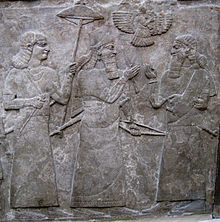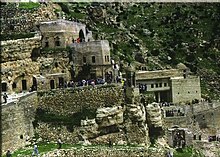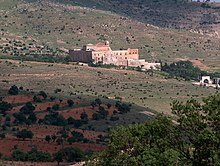Assyrian homeland
Assyria ܐܬܘܪ ( Classical Syriac )Āṯōr | ||
|---|---|---|
Star of Shamash
| ||
Ethnic groups Assyrian people (historical majority) | | |
| Religion | Syriac Christianity | |
| Demonym(s) | Assyrian Syrian, Syriac (historically) | |
| Today part of | ||
The Assyrian homeland, Assyria (
The Assyrians are indigenous Mesopotamians, descended from the Akkadians and Sumerians, who developed independent civilisation in the city of Assur on the eastern border of northern Mesopotamia. The territory that would encompass the Assyrian homeland was divided through the centre by the Tigris River, with their indigenous Mesopotamia on the west and western margins of the Urmia Plains, which they occupied in 2000 BCE prior to the arrival of the modern Iranians, to the east. In modern times, Assyrians largely only recognise Assyrian towns and cities immediately neighbouring the Tigris to the east as their indigenous territory, in addition to Mesopotamia,[5][6] with the homeland only expanding beyond the borders due to the major centres of Assyrian civilisation, such as the cities of Nineveh, Assur and Nimrud, being built on the banks of the Tigris itself.
Modern Assyrians are predominantly Christian, mostly adhering to the East and West Syriac liturgical rites of Christianity.[7] They speak Neo-Aramaic languages, most common being Suret and Turoyo.[8]
History
Ancient period

The city of Aššur and Nineveh (modern-day Mosul), which was the oldest and largest city of the ancient Assyrian empire,[9] together with a number of other Assyrian cities, seem to have been established by 2600 BC. However it is likely that they were initially Sumerian-dominated administrative centres. In the late 26th century BC, Eannatum of Lagash, then the dominant Sumerian ruler in Mesopotamia, mentions "smiting Subartu" (Subartu being the Sumerian name for Assyria). Similarly, in c. the early 25th century BC, Lugal-Anne-Mundu the king of the Sumerian state of Adab lists Subartu as paying tribute to him.[10]
Assyrians are eastern
During the Assyrian period
Early Christian period

Syriac Christianity took hold amongst the Assyrians between the 1st and 3rd centuries AD with the founding in Assyria of the Church of the East together with Syriac literature.[15]
The first division between
After the
Middle Ages

Both Syriac Christianity and the Eastern Aramaic language came under pressure following the
The mountainous region of the Assyrian homeland,
In 1552, a schism occurred within the Church of the East: the established "Eliya line" of patriarchs was opposed by a rival patriarch, Sulaqa, who initiated what is called the "Shimun line". He and his early successors entered into communion with the Catholic Church, but in the course of over a century their link with Rome grew weak and was openly renounced in 1672, when Shimun XIII Dinkha adopted a profession of faith that contradicted that of Rome, while he maintained his independence from the "Eliya line". Leadership of those who wished to be in communion with Rome passed to the Archbishop of Amid Joseph I, recognized first by the Turkish civil authorities (1677) and then by Rome itself (1681).[23][24][25][26]
A century and a half later, in 1830, headship of the Catholics was conferred on Yohannan Hormizd. Yohannan was a member of the "Eliya line" family, but he opposed the last of that line to be elected in the normal way as patriarch, Ishoʿyahb (1778–1804), most of whose followers he won over to communion with Rome, after he himself was irregularly elected in 1780, as Sulaqa was in 1552. The "Shimun line" that in 1553 entered communion with Rome and broke it off in 1672 is now that of the church that in 1976 officially adopted the name "Assyrian Church of the East",[27][28][29][30] while a member of the "Eliya line" family is one of the patriarchs of the Chaldean Catholic Church.
For many centuries, from at least the time of
Previously, when there were as yet no Catholic Aramaic speakers of Mesopotamian origin, the term "Chaldean" was applied with explicit reference to their "Nestorian" religion. Thus Jacques de Vitry wrote of them in 1220/1 that "they denied that Mary was the Mother of God and claimed that Christ existed in two persons. They consecrated leavened bread and used the 'Chaldean' (Syriac) language".[39] Until the second half of the 19th century the term "Chaldean" continued in general use for East Syriac Christians, whether "Nestorian" or Catholic:[40][41][42][43] it was the West Syriacs who were reported as claiming descent from Asshur, the second son of Shem.[44]
Early modern period
Syria and Upper Mesopotamia became part of the Ottoman Empire in the 16th century, following the conquests of Suleiman the Magnificent.[47]
Modern period

During World War I the Assyrians suffered the
Assyrians faced reprisals under the
The

In addition to the Assyrian population, an
Attacks on Christians
Following the concerted attacks on Assyrian Christians in Iraq, especially highlighted by the Sunday, August 1, 2004, simultaneous bombing of six Churches (Baghdad and Mosul) and subsequent bombing of nearly thirty other churches throughout the country, Assyrian leadership, internally and externally, began to regard the Nineveh Plain as the location where security for Christians may be possible. Schools especially received much attention in this area and in Kurdish areas where Assyrian concentrated population lives. In addition, agriculture and medical clinics received financial help from the
As attacks on Christians increased in
In August 2014 nearly all of the non-Sunni inhabitants of the southern regions of the Plains, which include
Soon after the beginning of the
Geography
Climate
Owing to its latitude and altitude, the Assyrian homeland is cooler and much wetter than most of Iraq. Most areas in the region fall within the
| Climate data for Tel Keppe | |||||||||||||
|---|---|---|---|---|---|---|---|---|---|---|---|---|---|
| Month | Jan | Feb | Mar | Apr | May | Jun | Jul | Aug | Sep | Oct | Nov | Dec | Year |
| Mean daily maximum °C (°F) | 12 (54) |
14 (57) |
20 (68) |
26 (79) |
34 (93) |
38 (100) |
43 (109) |
40 (104) |
38 (100) |
30 (86) |
20 (68) |
14 (57) |
27 (81) |
| Mean daily minimum °C (°F) | 2 (36) |
4 (39) |
8 (46) |
11 (52) |
16 (61) |
21 (70) |
25 (77) |
24 (75) |
20 (68) |
14 (57) |
6 (43) |
4 (39) |
13 (55) |
| Average precipitation mm (inches) | 39 (1.5) |
69 (2.7) |
51 (2.0) |
9 (0.4) |
0 (0) |
0 (0) |
0 (0) |
0 (0) |
0 (0) |
6 (0.2) |
36 (1.4) |
60 (2.4) |
270 (10.6) |
| Average precipitation days | 10 | 10 | 11 | 9 | 0 | 0 | 0 | 0 | 0 | 5 | 8 | 12 | 65 |
| Source: World Weather Online (2000-2012)[68] | |||||||||||||
| Climate data for Zakho | |||||||||||||
|---|---|---|---|---|---|---|---|---|---|---|---|---|---|
| Month | Jan | Feb | Mar | Apr | May | Jun | Jul | Aug | Sep | Oct | Nov | Dec | Year |
| Mean daily maximum °C (°F) | 10.2 (50.4) |
12.2 (54.0) |
16.5 (61.7) |
21.8 (71.2) |
29.1 (84.4) |
36.2 (97.2) |
40.4 (104.7) |
40.0 (104.0) |
35.7 (96.3) |
27.9 (82.2) |
19.4 (66.9) |
12.3 (54.1) |
25.1 (77.3) |
| Mean daily minimum °C (°F) | 1.9 (35.4) |
3.1 (37.6) |
6.1 (43.0) |
10.1 (50.2) |
15.0 (59.0) |
20.1 (68.2) |
23.7 (74.7) |
23.2 (73.8) |
19.2 (66.6) |
13.7 (56.7) |
8.4 (47.1) |
3.9 (39.0) |
12.4 (54.3) |
| Average precipitation mm (inches) | 144 (5.7) |
136 (5.4) |
129 (5.1) |
109 (4.3) |
43 (1.7) |
0 (0) |
0 (0) |
0 (0) |
1 (0.0) |
27 (1.1) |
83 (3.3) |
127 (5.0) |
799 (31.6) |
| Source: [69] | |||||||||||||
Demographics

Assyrian populations are distributed between the Assyrian homeland and the
The Assyrian communities that are still left in the Assyrian homeland are in
More than half of
Creation of an Assyrian autonomous province
The Assyrian-inhabited towns and villages on the Nineveh Plain form a concentration of those belonging to Syriac Christian traditions, and since this area is the ancient home of the Assyrian empire through which the Assyrian people trace their cultural heritage, the Nineveh Plain is the area on which an effort to form an
In the
On January 21, 2014, the Iraqi government had declared that Nineveh Plains would become a new province, which would serve as a safe haven for Assyrians.
Between the 28th-30 June 2017, a conference was held in Brussels dubbed, The Future for Christians in Iraq.[85] The conference was organised by the European People's Party and had participants extending from Assyrian/Chaldean/Syriac organizations, including representatives from the Iraqi government and the KRG. The conference was boycotted by the Assyrian Democratic Movement, Sons of Mesopotamia, Assyrian Patriotic Party, Chaldean Catholic Church and Assyrian Church of the East. A position paper was signed by the remaining political organizations involved.[86]
See also
- Assur
- Nineveh Plains
- Beth Nahrain
- Hakkari
- List of Assyrian settlements
- Persian Assyria
- Tur Abdin
- Asōristān
- Kurdistan
References
- ^ a b The Origins of War: From the Stone Age to Alexander the Great By Arther Ferrill – p. 70
- ^ Odisho, Devi (February 12, 2016). "Canada and the Future of Assyria". Foreign Policy Journal. Retrieved June 22, 2020.
- ^ ISBN 978-1-135-19388-1.
- ^ Macuch, R. (1987). “ASSYRIANS IN IRAN i. The Assyrian community (Āšūrīān) in Iran.” Encyclopædia Iranica, II/8. pp. 817-822
- ^ "Assyrians: "3,000 Years of History, Yet the Internet is Our Only Home"". www.culturalsurvival.org. 30 March 2022. Retrieved 2022-11-06.
- ^ "The Issue of An Assyrian Homeland". Seyfocenter. 2020-03-06. Retrieved 2022-11-06.
- ^ For Assyrians as a Christian people, see
- Joel J. Elias, The Genetics of Modern Assyrians and their Relationship to Other People of the Middle East
- Steven L. Danver, Native Peoples of the World: An Encyclopedia of Groups, Cultures and Contemporary Issues, p. 517
- ISBN 3-447-02744-4.
- ^ "Nineveh". Max Mallowan. 9 July 2023.
- ISBN 978-019-518364-1. Retrieved 16 May 2015.
- ^ J. A. Brinkman (2001). "Assyria". In Bruce Manning Metzger, Michael David Coogan (ed.). The Oxford companion to the Bible. Oxford University Press. p. 63.
- ^ Biblical Archaeology Review May/June 2001: Where Was Abraham's Ur? by Allan R. Millard
- ^ Société des études arméniennes, Fundação Calouste Gulbenkian, Association de la revue des études arméniennes (1989). Revue des études arméniennes, Volume 21. pp. 303, 309.
{{cite book}}: CS1 maint: multiple names: authors list (link) - ^ NAARDA, Dictionary of Greek and Roman Geography (1854)
- Brock, Sebastian P. (2005). "The Syriac Orient: A Third 'Lung' for the Church?". Orientalia Christiana Periodica. 71: 5–20.
- ^ Parpola, Simo. "ASSYRIAN IDENTITY IN ANCIENT TIMES AND TODAY" (PDF).
- ^ Fuller, 1864, pp. 200–201.
- ^ Hill, Henry, ed (1988). Light from the East: A Symposium on the Oriental Orthodox and Assyrian Churches. Toronto, Canada. pp. 108–109
- ^ "History of Ashur". Assur.de. Retrieved 12 June 2012.
- ^ Massacres, Resistance, Protectors: Muslim-Christian Relations in Eastern Anatolia during World War I By David Gaunt – p. 9, map p. 10.
- ^ Islamic desk reference, E. J. van Donzel
- ^ A modern history of the Kurds, David McDowall
- ISBN 978-1-134-43019-2.
- ISBN 978-1-118-32523-0.
- ISBN 9004116419– via Google Books.
- ^ "Fred Aprim, "Assyria and Assyrians Since the 2003 US Occupation of Iraq"" (PDF). Retrieved October 12, 2019.
- ISBN 978-1-134-43019-2.
- ISBN 978-1-118-32523-0.
- ISBN 9004116419– via Google Books.
- ^ "Fred Aprim, "Assyria and Assyrians Since the 2003 US Occupation of Iraq"" (PDF). Retrieved October 12, 2019.
- ISBN 978-90-04-22802-3.
- ^ Julius Fürst (1867). A Hebrew and Chaldee Lexicon to the Old Testament: With an Introduction Giving a Short History of Hebrew Lexicography. Tauchnitz.
- ^ Wilhelm Gesenius; Samuel Prideaux Tregelles (1859). Gesenius's Hebrew and Chaldee Lexicon to the Old Testament Scriptures. Bagster.
- ^ Benjamin Davies (1876). A Compendious and Complete Hebrew and Chaldee Lexicon to the Old Testament, Chiefly Founded on the Works of Gesenius and Fürst ... A. Cohn.
- )
- ^ "Council of Basel-Ferrara-Florence, 1431-49 A.D.
- ^ Braun-Winkler, p. 112
- ISBN 978-0-521-81113-2.
- ^ Wilhelm Braun, Dietmar W. Winkler, The Church of the East: A Concise History (RoutledgeCurzon 2003), p. 83
- JSTOR 1797632.
- ^ William F. Ainsworth, Travels and Researches in Asia Minor, Mesopotamia, Chaldea and Armenia (London 1842), vol. II, p. 272, cited in John Joseph, The Modern Assyrians of the Middle East (BRILL 2000), pp. 2 and 4
- ^ Layard, Austen Henry (July 3, 1850). Nineveh and its remains: an enquiry into the manners and arts of the ancient assyrians. Murray. p. 260 – via Internet Archive.
Chaldaeans Nestorians.
- ^ Simon (oratorien), Richard (July 3, 1684). "Histoire critique de la creance et des coûtumes des nations du Levant". Chez Frederic Arnaud – via Google Books.
- ^ Southgate, Horatio (July 3, 1844). Narrative of a Visit to the Syrian [Jacobite] Church of Mesopotamia. D. Appleton. p. 141 – via Internet Archive.
southgate papal chaldean.
- ^ Abul Fazl-i-Ạllámí (1894), "Description of the Earth", The Áin I Akbarí, vol. III, Translated by H.S. Jarrett, Calcutta: Baptist Mission Press for the Asiatic Society of Bengal, pp. 25–27.
- ISBN 9780837076799. Retrieved 23 December 2014.
- ^ "Ottoman Empire | Facts, History, & Map | Britannica". www.britannica.com. 2023-07-03. Retrieved 2023-08-13.
- ^ David Gaunt, "The Assyrian Genocide of 1915", Assyrian Genocide Research Center, 2009
- ISBN 978-1-4008-4184-4. Retrieved 26 February 2015.
- ^ Genocide Scholars Association Officially Recognizes Assyrian Greek Genocides. 16 December 2007. Retrieved 2010-02-02
- ISBN 1-4128-0619-4.
- ^ Travis, Hannibal. "Native Christians Massacred: The Ottoman Genocide of the Assyrians During World War I." Genocide Studies and Prevention, Vol. 1, No. 3, December 2006.
- ^ "Mar Narsi church – Dhouk". www.ishtartv.com.
- ISBN 9789004167650– via Google Books.
- ^ Centre, UNESCO World Heritage. "Ashur (Qal'at Sherqat)". whc.unesco.org.
- ^ a b Griffis, Margaret (19 January 2017). "Militants Execute Civilians in Mosul; 101 Killed Across Iraq". Antiwar.com. Retrieved 20 January 2017.
- ^ "Relief Projects - Assyrian Aid Society - Iraq". www.assyrianaidiraq.org.
- ^ "Assyrian Aid Society of America". Archived from the original on 2016-03-04. Retrieved 2017-07-12.
- ^ Chulov, Martin; Hawramy, Fazel (9 August 2014). "'Isis has shattered the ancient ties that bound Iraq's minorities'". The Guardian. Retrieved 11 August 2014.
- ^ Barnes, Julian E.; Sparshott, Jeffrey; Malas, Nour (8 August 2014). "Barack Obama Approves Airstrikes on Iraq, Airdrops Aid". Wall Street Journal – via online.wsj.com.
- ^ "Aiding the Assyrians Fight Against ISIS". The Huffington Post. 2015-04-15. Retrieved 2016-05-02.
- ^ "ISIL video shows destruction of Mosul artefacts", Al Jazeera, 27 Feb 2015
- ^ Buchanan, Rose Troup and Saul, Heather (25 February 2015) Isis burns thousands of books and rare manuscripts from Mosul's libraries The Independent
- ^ "Assyrian Militia in Iraq Battles Against ISIS for Homeland". www.aina.org. Retrieved 2017-04-17.
- ^ Alkhshali, Hamdi; Smith-Spark, Laura; Lister, Tim (22 October 2016). "ISIS kills hundreds in Mosul area, source says". CNN. Retrieved 22 October 2016.
- ^ "Iraqi residents flee Islamic State-held town of Tel Keyf". YouTube. Reuters. 10 January 2017. Archived from the original on 2021-12-19. Retrieved 12 January 2017.
- ^ "Shaqlawa". Ishtar Broadcasting Corporation.
- ^ "Tel Kaif, Ninawa Monthly Climate Average, Iraq". World Weather Online. Retrieved 22 January 2017.
- ^ "Climate: zakho". Climate-Data. Retrieved 21 January 2017.
- ^ "UNPO: Assyria". www.unpo.org.
- ISBN 978-0-7486-8605-6.
- ^ "Syria's Assyrians threatened by extremists – Al-Monitor: the Pulse of the Middle East". Al-Monitor. Retrieved 18 February 2015.
- ^ "مسؤول مسيحي : عدد المسيحيين في العراق تراجع الى ثلاثمائة الف". Retrieved 18 February 2015.
- ^ a b "Ishtar: Documenting The Crisis In The Assyrian Iranian Community". aina.org.
- ^ United Nations High Commissioner for Refugees (2010-10-13). "Iran: Last of the Assyrians". Refworld. Retrieved 2013-09-18.
- ^ United Nations High Commissioner for Refugees. "Refworld – World Directory of Minorities and Indigenous Peoples – Turkey : Assyrians". Refworld.
- ^ Rev. W.A. Wigram (1929). The Assyrians and Their Neighbours. London.
- ^ Assyria. UNPO (2008-03-25). Retrieved on 2013-12-08.
- ^ Iraqi Christians hold critical meeting Archived 2011-07-04 at the Wayback Machine, The Kurdish Globe
- ^ Dutch MP calls for autonomous Assyrian Christian region in north Iraq, AKI
- ^ "Archived copy" (PDF). Archived from the original (PDF) on 2014-10-14. Retrieved 2017-07-12.
{{cite web}}: CS1 maint: archived copy as title (link) - ^ "Iraq Sustainable Democracy Project". Iraqdemocracyproject.org. 2008-02-19. Retrieved 2012-08-17.
- ^ BetBasoo, Peter; Nuri Kino (22 January 2014). "Will a Province for Assyrians Stop Their Exodus From Iraq?". Assyrian International News Agency. Retrieved 6 December 2016.
- ^ "Iraqi Christians ask EU to support the creation of a Nineveh Plain Province". Archived from the original on 2020-11-17. Retrieved 2017-07-12.
- ^ "christians-in-iraq". christians-in-iraq. Archived from the original on 2018-08-29. Retrieved 2017-09-10.
- ^ "The Future of the Nineveh Plain - Government - Politics". Scribd.


